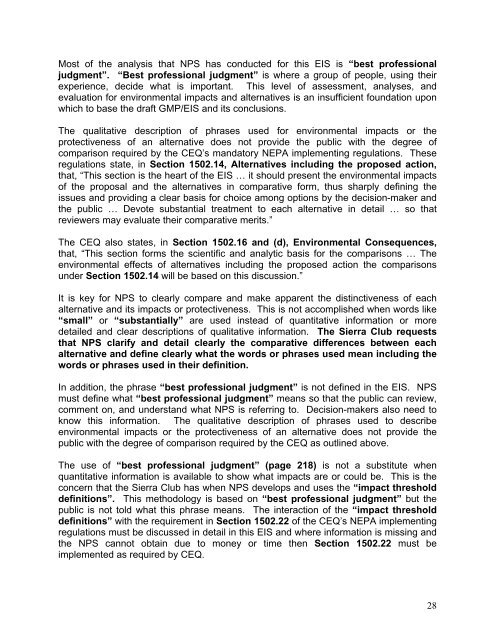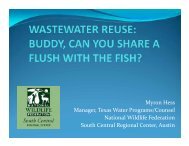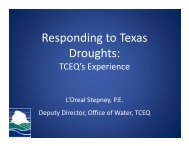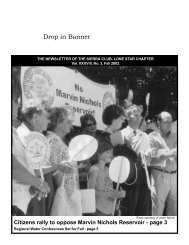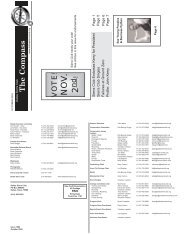comments in PDF - Lone Star Chapter, Sierra Club
comments in PDF - Lone Star Chapter, Sierra Club
comments in PDF - Lone Star Chapter, Sierra Club
Create successful ePaper yourself
Turn your PDF publications into a flip-book with our unique Google optimized e-Paper software.
Most of the analysis that NPS has conducted for this EIS is “best professional<br />
judgment”. “Best professional judgment” is where a group of people, us<strong>in</strong>g their<br />
experience, decide what is important. This level of assessment, analyses, and<br />
evaluation for environmental impacts and alternatives is an <strong>in</strong>sufficient foundation upon<br />
which to base the draft GMP/EIS and its conclusions.<br />
The qualitative description of phrases used for environmental impacts or the<br />
protectiveness of an alternative does not provide the public with the degree of<br />
comparison required by the CEQ’s mandatory NEPA implement<strong>in</strong>g regulations. These<br />
regulations state, <strong>in</strong> Section 1502.14, Alternatives <strong>in</strong>clud<strong>in</strong>g the proposed action,<br />
that, “This section is the heart of the EIS … it should present the environmental impacts<br />
of the proposal and the alternatives <strong>in</strong> comparative form, thus sharply def<strong>in</strong><strong>in</strong>g the<br />
issues and provid<strong>in</strong>g a clear basis for choice among options by the decision-maker and<br />
the public … Devote substantial treatment to each alternative <strong>in</strong> detail … so that<br />
reviewers may evaluate their comparative merits.”<br />
The CEQ also states, <strong>in</strong> Section 1502.16 and (d), Environmental Consequences,<br />
that, “This section forms the scientific and analytic basis for the comparisons … The<br />
environmental effects of alternatives <strong>in</strong>clud<strong>in</strong>g the proposed action the comparisons<br />
under Section 1502.14 will be based on this discussion.”<br />
It is key for NPS to clearly compare and make apparent the dist<strong>in</strong>ctiveness of each<br />
alternative and its impacts or protectiveness. This is not accomplished when words like<br />
“small” or “substantially” are used <strong>in</strong>stead of quantitative <strong>in</strong>formation or more<br />
detailed and clear descriptions of qualitative <strong>in</strong>formation. The <strong>Sierra</strong> <strong>Club</strong> requests<br />
that NPS clarify and detail clearly the comparative differences between each<br />
alternative and def<strong>in</strong>e clearly what the words or phrases used mean <strong>in</strong>clud<strong>in</strong>g the<br />
words or phrases used <strong>in</strong> their def<strong>in</strong>ition.<br />
In addition, the phrase “best professional judgment” is not def<strong>in</strong>ed <strong>in</strong> the EIS. NPS<br />
must def<strong>in</strong>e what “best professional judgment” means so that the public can review,<br />
comment on, and understand what NPS is referr<strong>in</strong>g to. Decision-makers also need to<br />
know this <strong>in</strong>formation. The qualitative description of phrases used to describe<br />
environmental impacts or the protectiveness of an alternative does not provide the<br />
public with the degree of comparison required by the CEQ as outl<strong>in</strong>ed above.<br />
The use of “best professional judgment” (page 218) is not a substitute when<br />
quantitative <strong>in</strong>formation is available to show what impacts are or could be. This is the<br />
concern that the <strong>Sierra</strong> <strong>Club</strong> has when NPS develops and uses the “impact threshold<br />
def<strong>in</strong>itions”. This methodology is based on “best professional judgment” but the<br />
public is not told what this phrase means. The <strong>in</strong>teraction of the “impact threshold<br />
def<strong>in</strong>itions” with the requirement <strong>in</strong> Section 1502.22 of the CEQ’s NEPA implement<strong>in</strong>g<br />
regulations must be discussed <strong>in</strong> detail <strong>in</strong> this EIS and where <strong>in</strong>formation is miss<strong>in</strong>g and<br />
the NPS cannot obta<strong>in</strong> due to money or time then Section 1502.22 must be<br />
implemented as required by CEQ.<br />
28


